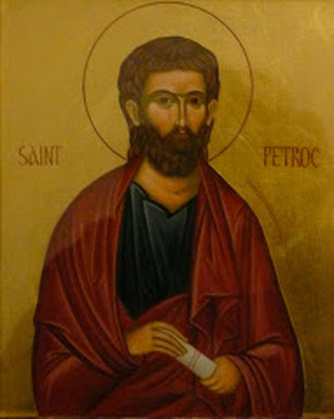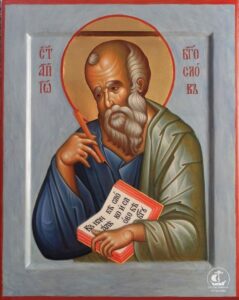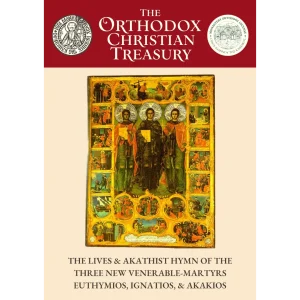SAINT PETROC, ABBOT OF PADSTOW And Those with Him – June 4

by Dr. Vladimir Moss
Our holy Father Petroc (or Pedrog) was born in about 468, the third of ten children of King Glywys Cernvw of Glywysing (Dyfed, Wales). After the death of his father, the people wanted Petroc to take his place, but the saint wanted to devote himself to the religious life. So his brother Winleu (Gwynllyw) became king instead, becoming the father of St. Cadoc. Accompanied by a band of followers, Petroc set off for Ireland, where he learned the monastic life from various teachers for about twenty years. Then he decided to return to Britain. Returning to the shore, he found the same ship in which he had sailed to Ireland, miraculously free from damage and dilapidation. “Regarding it as a good omen for the voyage they were about to begin, he boarded the ship with greater confidence than a practiced sailor, though untrained in navigation, and was followed by his band of disciples rejoicing. At the command of the servant of God, they haul up the sails to the top of the mast, believing what they had learnt from their true Master – that all things would be possible to the saints. The sails spread, the ship was borne along by the fear of God with great rapidity, although the winds were adverse. To confirm the sense of miraculous intervention in the minds of the simple crew, the intervening space of ocean was crossed in a very short time, and the ship arrived at the same calm haven which they had desired.” (St. Méen) They landed at Trebetherick in St. Minver’s parish, on the north bank of the River Camel in Cornwall. Now at that time St. Samson [perhaps the first bishop of Dol in Brittany], was living in solitude by the sea-shore. Lifting his eyes towards the sea, he was astonished to see with what extraordinary speed Petroc’s boat was advancing over the water, and he prayed to God to humble those who were sailing in such an unusual way, “lest they should be puffed up. Then a certain man, acting as under-pilot, traveling along the sand and incautiously slipping, was drowned in the channel. The name of the under-pilot who died was Reu…” (Gotha MS) Petroc and his disciples were saddened by this event. But they landed, and seeing some reapers in the field, Petroc went up to them, courteously saluted them and asked them how they were and of what religion they were. The reapers answered rudely, scoffing at what seemed to them to be their ridiculous monastic attire. And they said – perhaps to test the strangers’ sanctity – that they were tired and thirsty and would be glad if a fountain of fresh water would spring out of the rock so that they could quench their thirst. Petroc immediately prayed, struck a rock with his staff, and a fountain of salubrious water sprung up before their eyes… The reapers were astonished by the miracle and gave thanks to God. Then Petroc asked them whether they knew of any religious man in the area. They told him about St. Samson’s holy life, all-night prayers and extreme fasting. Delighted by this news, St. Petroc set off in the direction of St. Samson’s cell, earnestly praying that Samson would not depart from that place before he had had a chance to speak to him. “Immediately Samson’s limbs became stiff as stone. In vain did he attempt to put his hands to the instrument with which he was turning the soil. Thus had he been bound by the prayer of the man of God. Meanwhile the holy Petroc had reached him, and at the voice of his salutation Samson was freed from that stone-like rigidity, and, after they had exchanged the kiss of peace, he gave glory to God for the virtue and holiness which he had revealed by so great a miracle. “After the servant of God had had a short conference with Samson, receiving permission to depart, he turned his steps towards the cell of Bishop Wethnoc, which Samson had pointed out to him. Wethnoc received him courteously, and entertained both him and his companions honourably in the true spirit of hospitality. Next morning the servant of God resolved to make a permanent stay in that place, and approaching Wethnoc he earnestly desires leave to live with him. The bishop gladly agreed and promised of his own accord to make over the cell to him altogether, because he was confident that Petroc was the very man whom an ancient prophecy current in the neighbourhood had foretold was to come from Ireland and to magnify the name of the Lord Jesus Christ far and nearby the merits of the highest sanctity. He asked however, and obtained, that that place in memory of him should be called by his name. Wherefore in the language of that nation it is called Llanduwethinich [Lawethinoc, “the cemetery of Wethinoc”, now Padstow, “Petroc’s place”]. Bishop Wethnoc therefore with his men departed, rejoicing that he had been worthy to prepare a place of habitation for the man of God, and blessed Petroc entered the cell with his disciples, and therefor full thirty years he lived, and led so innocent a life that he did to none what he would not be done to himself, and so afflicted his body with vigils and endurance of cold that, to repress the unlawful motions of concupiscence, he often plunged himself into the middle of a torrent, and stood there naked from cockcrow till dawn…” (St. Méen) “And to guard against the possibility of disagreement with his neighbours arising from disputed boundaries, he surrounded the limits of his lands with very long ditches, dug deep like valleys, the ruins of which remain to this day, thus occupying his monks with bodily labours and warding off the danger of idleness. Also, in the place which is at Nant Funttum, that is, the Valley of the Fountain, he constructed an oratory, and a mill close by, at vast cost and by daily labours. And because the place where the work was being carried on was at some distance from the monastery, to occupy himself during his journeys to and fro he is said to have carried on his shoulders each morning and evening a stone of great size, in memory of which the same stone is place and placed on his tomb, and to this day scrapings from the same stone, mixed with water, confer prompt remedy on the faithful who are sick.” (Gotha MS) At length, the saint decided to go on pilgrimage to Rome. After venerating the holy places, he and his disciples returned home and were at Newton on the border of Cornwall [Newton St. Pettock in North Devon] when a great storm of wind and rain assailed them, rendering the roads impassable. His disciples began to grumble about this. But “the servant of God checked their murmuring, promising the next day it would be fine, and they would have a prosperous journey. But when the next day arrived, the storm did not cease. Which when the servant of God saw, he began to be sorrowful, and to accuse himself of presumption because he had promised what God’s Providence had not ordained. When the tempest ceased on the third day, and his companions wished to proceed on their journey, he announced that he was going on a pilgrimage to Rome, because he had been rash with his tongue and prophesied falsely, and not in accordance with what God had disposed. They consented, albeit with regret, and after exchanging the kiss of charity they separated with tears, and so they returned to Cornwall and he set out for Rome.” (St. Méen) While he was in Italy, Petroc visited the shrine of the holy Archangel Michael in Monte Gargano, and then went on to Jerusalem and the Holy Sepulchre. At length, after much traveling, the saint returned home to Cornwall. “There reigned at that time Teudur, a cruel and fierce man who, to punish thieves and criminals, had with savage cruelty caused various serpents and all kinds of noxious worms to be collected in a marshy lake. At his death, his son, who succeeded him in the kingdom by hereditary right, forbade this kind of torment to be inflicted upon men, and the hungry reptiles turned and destroyed one another by frequent attacks with the livid tooth so that out of so great a number only one remained – a horrible monster of enormous size who tore to pieces cattle and men in fearful fashion with his savage jaws.” On hearing of this peril, St. Petroc approached the monster together with Bishop Wethnoc, and, binding him with his stole, led him towards the sea. But then “the man of God met a party of 300 men carrying, amid loud lamentations, the lifeless body of a prince’s son, to fulfill the rites of burial according to the custom of the country. They were terrified at the sight of this most hideous monster, and some fell prostrate on the ground like dead men; others, trembling as they stood, were hardly able to carry the bier, so overwhelmed were they with sudden horror and anguish at the sight of the reptile. The servant of God, therefore, taking pity on the mourners, kneeled and prayed, and having implored the clemency of the Almighty restored to all their strength and raised to life again the young man whom they had been bearing as a corpse. Then, while they were rejoicing in the praises of God, the saint commanded the monster which had bound to hurt no one anymore and to depart to solitudes beyond the seas…” (St. Méen) Now Petroc, feeling the infirmities of old age since his return from his long pilgrimage, and wishing to withdraw from the cares and disputes of the monastery, “took with him two brethren, Peter and Dator, and secretly departed to Nanceventon [Little Petherick], and there lived in retirement fifteen days. Then fearing that his brethren might be concerned about his unexplained absence, he determined to see them again and afterwards to return to his retreat when the affairs [of the monastery] had been duly settled, with the consent of his brethren, after the matter had been discussed with them. He summons the brethren and informs them that he is no longer equal to the task of managing business matters and that he wishes to live a retired life with a few chosen [monks]. He bids them elect an administrator, fit to undertake the burden of ruling the church, whom he may place in his own seat [cathedra] instead of himself; who must be a worthy pastor of souls, and an energetic man of affairs, fearing God and blameless. Now there was there a certain man, well instructed, named Peter, recently professed, but esteemed by his brethren as a man of holy life, and ‘having a good report of them which are without’. After prayer, he was unanimously elected, and Petroc transferred to him the pastoral charge. Then, taking twelve brethren, after exchanging the kiss of peace, he departed, and they made lodging-places for themselves at Nanceventon in different cells. He himself had a cell constructed of logs, and likewise some of the brethren, but many withdrew to caves in the hills or hollow places in the valleys. They met together for solemn prayers and for meals. But they suffered from lack of water, which had to be brought with considerable trouble from a long distance, for the water of the river could not be drunk, as it was mixed with saltwater coming up from the sea. So the venerable old man, after singing the Praises, as usual, full of faith struck his staff into the ground on the right-hand side of the cell, and repeated the miracle [of Trebetherick], causing a well of purest water, sweet to the taste, to spring forth.” (Gotha MS) “On a certain day when the servant of God was praying alone in a place where he had been accustomed to pray, he saw a stag appear in the distance, fleeing towards him as hard as he could go, pursued by the huntsmen of Constantine, a rich man, with hallooing and barking of dogs. The servant of God moved with kindly feeling, protected it from being hurt. The stag was being followed by the chieftain himself, to whom his soldiers, fearing to touch it while under the protection of the man of God, reported the matter in due order. Full of fury, Constantine would have struck the servant of God with his sword, but was suddenly smitten with paralysis, and became unable to move hand or foot, until he besought pardon and (at the petition of his soldiers) the saint released him by his pious prayers. After freeing him, he taught him and his nineteen [or twenty-four (Gotha MS)] soldiers the Christian Faith and made them gentle and kind instead of fierce tyrants, and worshippers of Christ instead of pagans. “One day, while the servant of God was at his meal, a jar of water which had been placed there was knocked over by accident, and the liquor was spilt. But Petroc, making the sign of the cross, took up the vessel immediately, full of heavenly nectar, which he tasted and handed to his brethren, who wondered at its sweetness. “The saint was watching in prayer out of doors on a Sunday, when the rain fell in abundance all around him but fell not upon him. “The servant of God and Bishop Wethnoc were [one day] alone, conversing together sweetly of heavenly things, when lo! A mantle of wondrous beauty descended [from heaven] between them. And when ‘in honour preferring one another’, each offered it to the other, and with pious contention heaped up reasons why the other should have it, straightway in their sight it was taken up into heaven. And immediately two were sent from heaven – one for each. “After they had spent several years in the aforesaid cell in holy life and conversation, the servant of God was directed by an angel to betake himself to some still more remote part of the wilderness, and found Vuron [or Goran], a most holy hermit, who, while winning his daily bread by the labour of his hands, never let his spirit cease from prayer. He asked and obtained from him the grace of hospitality, and they entered together into [Vuron’s] solitary habitation and found there bread and a white table placed for them there by God’s command. Refreshed by the wonderful sweetness of this meal they gave thanks to the divine goodness, and continued their sober colloquies; and then [after a revelation from God] Vuron departed to seek a new abode for himself [at Gorran, fifteen miles to the south]. Meanwhile, the anxious disciples had been seeking for Petroc through the wilderness, and when they had found him, they hailed him, and besought him to return, in spite of his desire to hide his sanctity [in the wilderness]…” (St. Méen) In the place where the hermit Vuron had lived, which is now Bodmin (“the abode of the monks”), the saint built a monastery. “Cynam [Cynan or Conon], a tribune in the country, was racked with agonizing pain; Petroc appeared to him by night as he slept and commanded him to set free the accused persons he was keeping in prison, [promising him] that if he would release them he would recover his health. On awaking, he related the vision to his wife, by whose counsel he loosed the prisoners from their chains, and felt himself completely recovered. “A certain woman also, who had suffered an issue of blood for several years, secretly touched the garment of the holy man and recovered her health as a reward of her faith. “But that the virtue of the saint should be known even to ‘beasts that are not clean’, a great dragon living near his cell in the wilderness, having got a piece of wood into his right eye, laying aside all wish to hurt, hastened to the temple where the saint was engaged in prayer, and reclining his head on the outer threshold lay there for three days, waiting for a miracle from God. By Petroc’s command, he was sprinkled with water mingled with dust from the pavement [or the foot of the altar (Gotha MS)], and straightway the wood removed by means of the [saint’s] prescription, and his sight restored, wonderful to relate! he returned to his accustomed wallowing place. “A woman, feeling thirsty one night, drank water out of a jug and swallowed a small serpent, [in consequence of which] she was for many years in bad health. As no physicians benefited her, she was brought to the holy man. He made a mixture of water and earth which he gave to the sick woman to drink, and immediately she had swallowed it she vomited a serpent three feet long, but dead, and the same hour she recovered her health and gave thanks to God.” (St. Méen) “After several years had passed, his body being worn out, partly by the exercises of the contemplative life, and partly by age,.. he wished to visit each of the places where the brethren abode, to confirm them and to bid them a last farewell, and on his journey, he began to find his strength suddenly fail him. And having greeted his monks at Nanceventon, he desired, before the rapid progress of his disease made it too late, to push on and visit the brethren of Lanwethinoc, and entered the house of a certain father of a family named Rovel, from whom that rus is to this day called Trerovel, that is, the Villa of Rovel and his growing weakness made it impossible for him to proceed further. Now the father of the family, having great compassion on him, accommodated him in a private chamber in which he might repose, taking great care of him. And as his languor hourly increased, he [Petroc] invited his special friends, united to him by spiritual ties, to recommend [to God] his departure in their prayers. Finally, his agony approached, and, having received the great viaticum of our redemption, on June 4 [in the year 564], about the fourth watch of the night, freed from the prison of the body, he shone forth like a star in that said chamber… “When therefore the death of this great patron is made public, the whole population of the province comes together, he is borne forth by an immense crowd of mourners… and is solemnly buried in the place which he had made glorious by the first fruits of his conversation [as a monk in Cornwall]. Close to his tomb a living fountain springs up, which cures sore eyes and internal complaints, if there be faith in the person seeking healing…” (Gotha MS) St. Petroc is commemorated on June 4 and October 1, and his fellow-struggler, St. Wethnoc – on November 7 in Cornwall, and on November 11 in Brittany (where he is known as St. Guenoc). St. Vuron (Goran) is commemorated on April 7. In the early tenth century King Athelstan of England gave to Exeter, among other relics of Breton saints he had received from grateful Breton friends, relics “of the body of S. Withenoc the Bishop”. Some time after the middle of the ninth century Bodmin became the major centre for St. Petroc’s veneration and his relics were moved there from Padstow. The Bodmin monastery soon became one of the wealthiest Cornish churches. In 963 King Edgar ordered a shrine to be built for the relics of the saint. It was “to be honourably gilded with gold and silver, in honour of S. Petroc the confessor of Christ, where his relics are kept, that by his merits I may obtain length of days both in this life and in that which is to come”. However, in 981 Bodmin was sacked by Viking pirates, and in about 1000 his relics were removed elsewhere for safe-keeping. In 1177, a Breton stole his relics and gave them to the Abbey of St Méen in Brittany, where his first life was written on the basis of older documents. (The other life, in the Gotha MS, is also twelfth century.) However, Henry II restored them to Bodmin (leaving one rib at St. Méen), and the head-reliquary, an ivory casket of Sicilian workmanship that used to hold them is still on public display in the church of St. Petroc at Bodmin. The holy relics were cast out during the English Reformation. Five churches are dedicated to St. Petroc in Cornwall, about the same number in Wales, in Devon – seventeen, and some also in Brittany.
St. Petroc is commemorated on June 4.
Holy Father Petroc, pray to God for us!
(Sources: Gilbert H. Doble, The Saints of Cornwall, part 4, Truro, 1985, pp. 132-166; David Farmer, The Oxford Dictionary of Saints, Oxford: The Clarendon Press, 1978, pp. 351-352; http://www.earlybritishkingdoms.com/bios/pedrogg.html; http://www.frpeterpreble.com/2011/06/6-june-st-petroc-abbot-of-padstow.html; Nick Mayhew Smith, Britain’s Holiest Places, Bristol: Lifestyle Press, 2011, pp. 155-156, 174)






